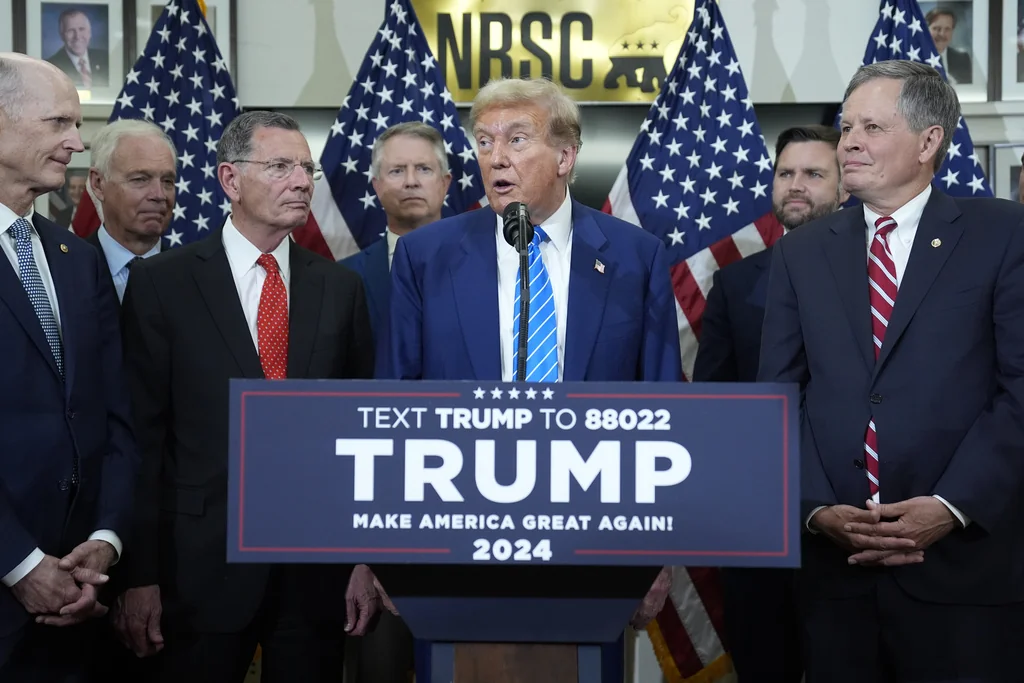


Senate Republicans are pushing the boundaries of fundraising laws to fill their campaign coffers and stretch their ad spending to counter Democrats ahead of the 2026 midterms.
The increased use of so-called joint fundraising committees to score cheaper ads is a relatively new trend that GOP operatives and candidates, particularly for the Senate, have leaned into the past year to save millions of dollars and mitigate what has historically been a Democratic fundraising advantage.
Recommended Stories
- Democrats confront 'cringe mountain' in bid to engage young voters
- Democrats release new California map that targets five GOP districts
- RFK Jr. dismisses questions about loyalty to Trump, says he will not run in 2028
“We think the use of JFCs … is a strategic option for us but is something everyone should do,” a senior GOP operative said. “If you don’t, you’re kind of running a campaign of the past.”
Joint fundraising committees allow candidates another avenue to raise and spend money from the same donors but separate from their principal campaign accounts, skirting traditional contribution limits for individual campaigns. The funds are shared between the candidate and other committees, such as the Senate GOP’s campaign arm.
Their existence is not a new phenomenon. But what is new is the way they’re being used, mostly by Senate GOP candidates, to stretch advertising dollars by using the money to purchase TV ads at a lower rate only offered to candidates. The move has prompted concerns from campaign finance ethics advocates, despite the Federal Election Commission effectively allowing the practice.
“Only somewhat recently we’ve been seeing them used in these creative ways that actually kind of undermine the larger scheme of campaign finance regulations, which exist, of course, to protect voters’ interests and transparency, and curb potential corruption,” said Saurav Ghosh, director of campaign finance reform at the Campaign Legal Center.
Senate Republican candidates began testing the strategy last year in states like Montana and Michigan after Republican and Democratic FEC regulators deadlocked on whether the ad spending is permitted, effectively greenlighting their use in a cycle where the GOP clawed back the majority. The continued lack of FEC action has since emboldened Senate Republicans to pump millions of dollars from joint committees into cheaper ads.
Joanna Rodriguez, a spokesperson for the Senate GOP’s campaign arm known as the National Republican Senatorial Committee (NRSC), described JFCs as “the most modern, efficient way for candidates to maximize the potential of hard-dollar donations.”
Republicans’ workaround to avoid potential violations, which some consider a “loophole,” is to include a fundraising request in what otherwise looks like a traditional campaign ad. The request often comes in the form of a QR code that’s briefly flashed on screen.
“It’s easy to raise a large amount … from donors in one shot, and you could use the money for multiple things,” a former NRSC official told the Washington Examiner. “They change the end [of the ad] to be a fundraiser component, and that enables them to do what would otherwise be similar to a campaign ad… and allow the committee to buy at a candidate rate.”
Super PACs also play a large role in candidates’ broader campaign apparatus. But unlike joint committees, they can’t coordinate with candidates or campaigns and thus face higher TV ad rates.
The joint fundraising tactic, coupled with other efforts by Republicans, has the potential to further transform the ways political parties and candidates raise money, that have the GOP looking to capitalize on.

ActBlue, the Democratic Party’s online fundraising platform, is the subject of state and federal investigations by Republicans over assertions, including from President Donald Trump, that it’s funneling illegal contributions to progressive candidates and causes.
And in a case before the Supreme Court, the NRSC is seeking to overturn a 2001 FEC ruling limiting coordinated spending between political parties and candidates. A decision by the conservative-leaning high court in favor of the NRSC “would essentially codify our approach” on joint fundraising, the senior GOP operative said.
In some instances, Republicans have also used the campaign-finance strategy to try and obscure lackluster fundraising quarters.
Last month, the campaign for Michigan GOP Senate hopeful Mike Rogers initially released misleading figures claiming a second-quarter haul of $1.5 million without disclosing that roughly half came from joint fundraising. The omission made it appear as though Rogers’ fundraising figures were stronger than they actually were, until the FEC filing hours later revealed he trailed all of his challengers. His joint fundraising committee shares the funds with four other entities, including the NRSC and Rogers’ campaign.
“It’s an artful way to paper over a less than a sub-optimal quarter,” said an operative for a former Republican Senate candidate. “If you’ve had a good quarter, you wouldn’t have a problem delineating for people what you raised where and be more transparent about it.”
By comparison, other GOP candidates clearly delineated between direct campaign figures and affiliated groups like joint fundraising committees.
Democrats also use joint fundraising but to a far lesser degree, a tendency that GOP operatives blame on alleged malpractices with ActBlue. Democrats say that trend is likely to change, particularly if it means keeping a level playing field with Republicans using fundraising methods deemed permissible by the courts and regulators.
HOW A SUPREME COURT CASE ON CAMPAIGN FINANCE COULD CHANGE ELECTIONS
Democrat Roy Cooper, the former North Carolina governor running to replace retiring Sen. Thom Tillis (R-NC), raised $900,000 through joint fundraising in his first 24 hours, buoying the $2.6 million raised directly by the campaign.
“If it proves to be effective and the regulators don’t seem to be doing anything about it, I think it’s going to become popular on both sides of the aisle,” said Ghosh of the Campaign Legal Center. “Whoever the first mover is — others are going to see that it’s working, and I think follow suit.”
Marisa Schultz contributed to this report.
